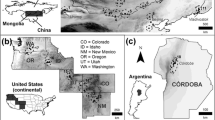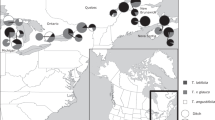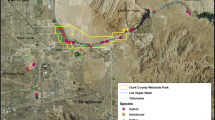Abstract
The presence of hybrid genotypes resulting from the mating of native and invasive species poses numerous problems to invasive species managers, including initial difficulty in hybrid detection, unpredictable ecological impacts to recipient ecosystems, and variability in response to management actions. We conducted a molecular study of internal transcribed spacer sequences to determine whether hybridization has occurred between the North American macrophyte Nymphoides aquatica and the invasive N. cristata where their distributions overlap in the southeastern United States (US). A hybrid N. aquatica × N. cristata population was detected within Lake Moultrie, in South Carolina. Given the broad geographic overlap in the distributions of N. aquatica and N. cristata in the southeastern US, and previously documented hybridization between the natives N. aquatica and N. cordata, additional monitoring for hybrid populations throughout the introduced range is strongly suggested. At a minimum, hybrid monitoring should take place in the nine counties of three states where both species are documented. Here, we discuss next steps to better characterize genetic diversity within hybrid Nymphoides populations and the potential management implications.


Similar content being viewed by others
Data availability
The datasets generated during and/or analyzed during the current study are available from the corresponding author on reasonable request. Sequences are available as GenBank accessions no. MW722964-MW722968.
References
Benson DA, Cavanaugh M, Clark K, Karsch-Mizrachi I, Lipman DJ, Ostell J, Sayers EW (2013) GenBank. Nucleic Acids Res 41:D36–D42. https://doi.org/10.1093/nar/gks1195
Blackburn R, Weldon L, Yeo R, Taylor T (1969) Identification and distribution of certain similar-appearing submersed aquatic weeds in Florida. Hyacinth Control J 8:17–21
Blair AC, Schaffner U, Häfliger P, Meyer SK, Hufbauer RA (2008) How do biological control and hybridization affect enemy escape? Biol Control 46:358–370. https://doi.org/10.1016/j.biocontrol.2008.04.014
Burks KC (2002) Nymphoides cristata (Roxb.) Kuntze, a recent adventive expanding as a pest plant in Florida. Castanea 67:206–211
FWC (2018) Background on the aquatic herbicides registered for use in Florida. University of Florida, IFAS Center for Aquatic and Invasive Plants. http://plants.ifas.ufl.edu/manage/control-methods/chemical-control/details-about-the-aquatic-herbicides-used-in-florida/. Accessed 31 Mar 2020
Gaskin JF et al (2011) Applying molecular-based approaches to classical biological control of weeds. Biol Control 58:1–21
Geiger JH, Pratt PD, Wheeler GS, Williams D (2011) Hybrid vigor for the invasive exotic Brazilian peppertree (Schinus terebinthifolius Raddi., Anacardiaceae) in Florida. Int J Plant Sci 172:655–663. https://doi.org/10.1086/659457
Gettys L, Della Torre CJ, Thayer KM, Markovich IJ (2017) Asexual reproduction and ramet sprouting of crested floatingheart (Nymphoides cristata). J Aquat Plant Manage 55:83–88
Harms NE, Nachtrieb JG (2019) Suitability of introduced Nymphoides spp. (Nymphoides cristata, N. peltata) as targets for biological control in the United States. ERDC/TN APCRP-BC-42, US Army Engineer Research and Development Center, Vicksburg, MS United States, 18pp
Huxel GR (1999) Rapid displacement of native species by invasive species: effects of hybridization. Biol Cons 89:143–152. https://doi.org/10.1016/S0006-3207(98)00153-0
Larue EA, Zuellig MP, Netherland MD, Heilman MA, Thum RA (2013) Hybrid watermilfoil lineages are more invasive and less sensitive to a commonly used herbicide than their exotic parent (Eurasian watermilfoil). Evol Appl 6:462–471. https://doi.org/10.1111/eva.12027
Martin LJ, Blossey B (2013) The runaway weed: Costs and failures of Phragmites australis management in the USA. Estuaries Coasts 36:626–632. https://doi.org/10.1007/s12237-013-9593-4
Michel A, Arias RS, Scheffler BE, Duke SO, Netherland M, Dayan FE (2004) Somatic mutation-mediated evolution of herbicide resistance in the nonindigenous invasive plant hydrilla (Hydrilla verticillata) Mol Ecol 13:3229–3237. https://doi.org/10.1111/j.1365-294X.2004.02280.x
Middleton BA, van der Valk AG, Davis CB (2015) Responses to water depth and clipping of twenty-three plant species in an indian monsoonal wetland. Aquat Bot 126:38–47. https://doi.org/10.1016/j.aquabot.2015.06.004
Morais P, Reichard M (2018) Cryptic invasions: a review. Sci Total Environ 613–614:1438–1448. https://doi.org/10.1016/j.scitotenv.2017.06.133
Netherland MD, Jones D (2015) Fluridone-resistant hydrilla (Hydrilla verticillata) is still dominant in the Kissimmee Chain of Lakes FL. Invas Plant Sci Manage 8:212–218. https://doi.org/10.1614/IPSM-D-14-00071.1
Pyšek P et al (2013) Hitting the right target: taxonomic challenges for, and of, plant invasions. AoB PLANTS. https://doi.org/10.1093/aobpla/plt042
Roley SS, Newman RM (2006) Developmental performance of the milfoil weevil, Euhrychiopsis lecontei (Coleoptera: Curculionidae), on northern watermilfoil, Eurasian watermilfoil, and hybrid (northern × eurasian) watermilfoil. Environ Entomol 35:121–126. https://doi.org/10.1603/0046-225x-35.1.121
Rüegg S, Bräuchler C, Geist J, Heubl G, Melzer A, Raeder U (2019) Phenotypic variation disguises genetic differences among Najas major and N. marina, and their hybrids. Aquat Bot 153:15–23. https://doi.org/10.1016/j.aquabot.2018.11.005
Saltonstall K (2002) Cryptic invasion by a non-native genotype of the common reed, Phragmites australis, into North America. Proc Natl Acad Sci 99:2445
Tamura K, Stecher G, Peterson D, Filipski A, Kumar S (2013) MEGA6: molecular evolutionary genetics analysis version 60. Mol Biol Evol 30:2725–2729
Thayer DD, Pfingsten IA (2020) Nymphoides cristata (Roxb.) Kuntze US Geological Survey. Accessed 30 Mar 2020
Tippery NP, Les D (2011a) Evidence for the hybrid origin of Nymphoides montana Aston (Menyanthaceae). https://doi.org/10.7751/telopea20116021
Tippery NP, Les DH (2011b) Phylogenetic relationships and morphological evolution in Nymphoides (Menyanthaceae), vol 36, BIOONE
Tippery NP, Les DH (2013) Hybridization and systematics of dioecious North American Nymphoides (N. aquatica and N. cordata; Menyanthaceae). Aquat Bot 104:127–137. https://doi.org/10.1016/j.aquabot.2012.08.003
Tippery NP, Sears NL, Zentner AB, Sivadas V (2018) Evidence for allopolyploid speciation in Nymphoides (Menyanthaceae). Syst Bot 43:117–129
Willey LN, Netherland MD, Haller WT, Langeland KA (2014) Evaluation of aquatic herbicide activity against crested floating heart. J Aquat Plant Manage 52:47–56
Williams WI, Friedman JM, Gaskin JF, Norton AP (2014) Hybridization of an invasive shrub affects tolerance and resistance to defoliation by a biological control agent. Evol Appl 7:381–393. https://doi.org/10.1111/eva.12134
Zuellig MP, Thum RA (2012) Multiple introductions of invasive Eurasian watermilfoil and recurrent hybridization with northern watermilfoil in North America. J Aquat Plant Manage 50:1–19
Acknowledgements
The authors would like to thank Cassidy Kempf, Michael Coulon, Tim Bister, Jacob Green, Casey Moorer, John Riser, and Carl Bussells for assistance in the field, laboratory, or greenhouse. Thanks to Nic Tippery for providing data on Nymphoides aquatica and N. cordata distribution in the United States from his previous work. Thanks also to Lynde Dodd and Denise Lindsay for review of an early version of this manuscript and the anonymous reviewers at the journal. This work was supported by the US Army Engineer Research and Development Center Aquatic Plant Control Research Program and the Montana Agricultural Experiment Station (Project MONB00249).
Author information
Authors and Affiliations
Contributions
NH, RT, RR, and LG contributed to the study conception and design. Field sampling and sample curation were done by NH, LG, and IM. Data collection and analysis were performed by RT, AF, and LS. The first draft of the manuscript was written by NH and all authors commented on previous versions of the manuscript. All authors read and approved the final manuscript.
Corresponding author
Ethics declarations
Conflict of interest
The authors declare that they have no conflict of interest.
Additional information
Publisher's Note
Springer Nature remains neutral with regard to jurisdictional claims in published maps and institutional affiliations.
Supplementary Information
Below is the link to the electronic supplementary material.
Rights and permissions
About this article
Cite this article
Harms, N.E., Thum, R.A., Gettys, L.A. et al. Hybridization between native and invasive Nymphoides species in the United States. Biol Invasions 23, 3003–3011 (2021). https://doi.org/10.1007/s10530-021-02558-9
Received:
Accepted:
Published:
Issue Date:
DOI: https://doi.org/10.1007/s10530-021-02558-9




